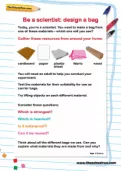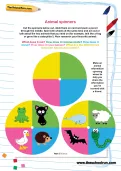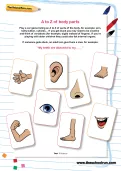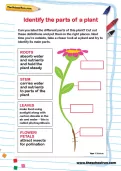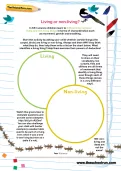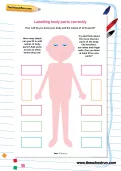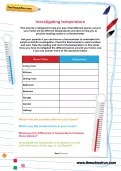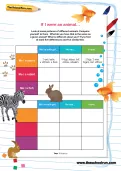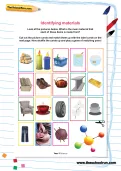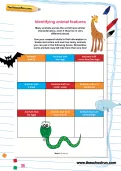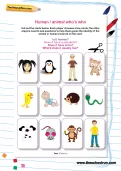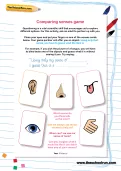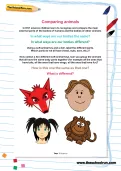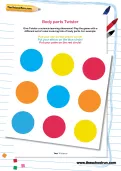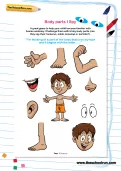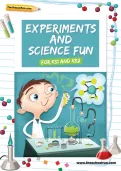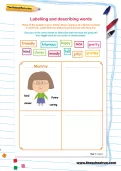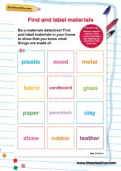In KS1 science children learn to differentiate between living and non-living things in terms of characteristics such as movement, growth and breathing. Identify which things are living and which are non-living, but watch out ... sometimes it's not as obvious as it seems!
or
Register to add to your saved resources
Already a subscriber? to view this content.
How many labels can you fill in with names of body parts? Add some arrows to show where they are! Try and think about the more obscure parts of the body. Can you learn at least three new parts?
or
Register to add to your saved resources
Already a subscriber? to view this content.
This activity is designed to help you learn that different places around your home will be different temperatures and also to help you to practise reading scales on a thermometer.
or
Register to add to your saved resources
Already a subscriber? to view this content.
Look at some pictures of different animals. Compare yourself to them. What do you have that is the same as a given animal? What is different about you? Try to find at least five differences and five similarities.
or
Register to add to your saved resources
Already a subscriber? to view this content.
Look at the pictures. What is the main material that each of these items is made from? Cut out the picture cards and match them up with the label cards on the next page. Now shuffle the cards up and play a game of matching pairs!
or
Register to add to your saved resources
Already a subscriber? to view this content.
Many animals across the world have similar characteristics, even if they live in very different places. Use your research skills to find information in books and online and see how many animals you can put in the following boxes. Remember, some animals may fall into more than one box!
or
Register to add to your saved resources
Already a subscriber? to view this content.
Cut out the cards. Each player chooses a few cards; the other players need to ask questions to help them guess the identity of the animal or human pictured on the card.
or
Register to add to your saved resources
Already a subscriber? to view this content.
Close your eyes and put your finger on one of these senses cards. Your game partner will offer you an object. Using only that sense, can you guess what the item is?
or
Register to add to your saved resources
Already a subscriber? to view this content.
Using a soft animal toy and a doll, label the different parts. Which parts do we all have (head, eyes, ears, etc.)? Now collect a few different soft animal toys. Can you group the animals that all have the same body parts together (for example all the ones that have tails, all the ones that have wings, all the ones that have fur)?
or
Register to add to your saved resources
Already a subscriber? to view this content.
Give Twister a science-learning dimension! Play the game with a different set of rules involving lots of body parts.
or
Register to add to your saved resources
A great game to help your child become familiar with human anatomy. Challenge them with tricky body parts (can they spy their humerus, ankle, kneecap or earlobe?).
or
Register to add to your saved resources
Already a subscriber? to view this content.
Go into your garden and see how many different plants you can find. How could you find out the names of these plants? Who could help you find out? Now play the find my leaf game!
or
Register to add to your saved resources
Already a subscriber? to view this content.
Cut the spinners out, stick them on card and push a pencil through the middle. Spin both wheels at the same time and act out or talk about the two animals that you land on (for example, talk like a frog or grow like a caterpillar!). Now research your favourite animal.
or
Register to add to your saved resources
Play a car game listing an A to Z of parts of the body, for example: arm, belly button, cuticles… If you get stuck you may need to be creative and think of variations (for example, digits instead of fingers). If you’re playing with older children they could also list internal organs!
or
Register to add to your saved resources
The letters in these boxes have been mixed up. Can you unjumble them to find the name of an animal?
or
Register to add to your saved resources
Already a subscriber? to view this content.
Beans, gingerbread men, ice, washing-up bottles and cocoa powder – that's all you need to demonstrate key KS1 and KS2 science concepts to your child at the kitchen table. Packed with simple experiments, fun games (Muffled Chinese Whispers, anyone?) and parent-friendly science explanations, our Experiments and science fun for KS1 and KS2 learning pack is all you need to make primary science come to life for your child.
or
Register to add to your saved resources
Draw a picture of a family member then label it and add some words to describe them around the picture.
or
Register to add to your saved resources
Already a subscriber? to view this content.
This activity will develop your child's imagination and design skills.
or
Register to add to your saved resources
This activity will teach your child the different properties of many common materials and help them identify why they are used.
or
Register to add to your saved resources
Already a subscriber? to view this content.
A Year 1 science worksheet on identifying the parts of a plant, created by a primary school teacher to support learning at home.
or
Register to add to your saved resources
